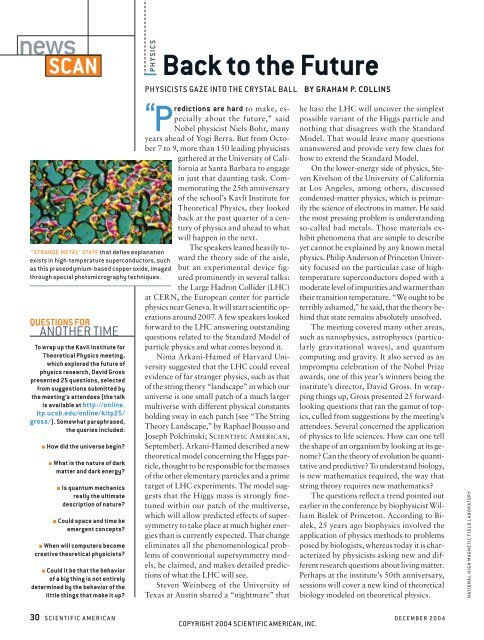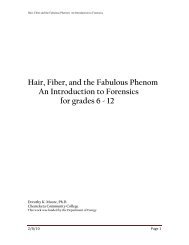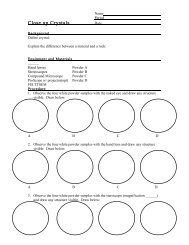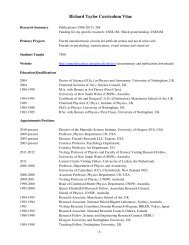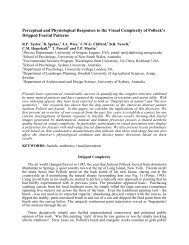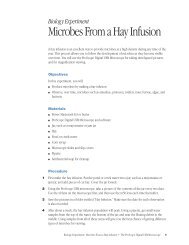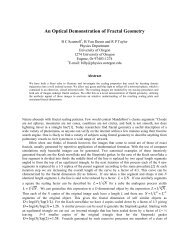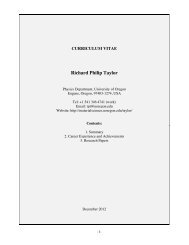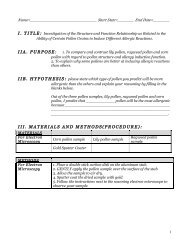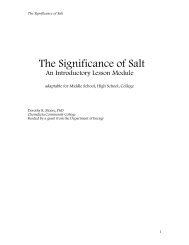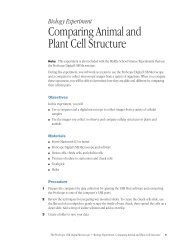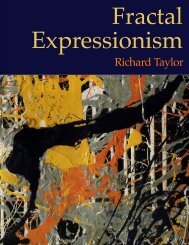December 2004 - Materials Science Institute - University of Oregon
December 2004 - Materials Science Institute - University of Oregon
December 2004 - Materials Science Institute - University of Oregon
Create successful ePaper yourself
Turn your PDF publications into a flip-book with our unique Google optimized e-Paper software.
news<br />
SCAN<br />
PHYSICS<br />
“STRANGE METAL” STATE that defi es explanation<br />
exists in high-temperature superconductors, such<br />
as this praseodymium-based copper oxide, imaged<br />
through special photomicrography techniques.<br />
QUESTIONS FOR<br />
ANOTHER TIME<br />
To wrap up the Kavli <strong>Institute</strong> for<br />
Theoretical Physics meeting,<br />
which explored the future <strong>of</strong><br />
physics research, David Gross<br />
presented 25 questions, selected<br />
from suggestions submitted by<br />
the meeting’s attendees (the talk<br />
is available at http://online.<br />
itp.ucsb.edu/online/kitp25/<br />
gross/). Somewhat paraphrased,<br />
the queries included:<br />
■ How did the universe begin?<br />
■ What is the nature <strong>of</strong> dark<br />
matter and dark energy?<br />
■ Is quantum mechanics<br />
really the ultimate<br />
description <strong>of</strong> nature?<br />
■ Could space and time be<br />
emergent concepts?<br />
■ When will computers become<br />
creative theoretical physicists?<br />
■ Could it be that the behavior<br />
<strong>of</strong> a big thing is not entirely<br />
determined by the behavior <strong>of</strong> the<br />
little things that make it up?<br />
Back to the Future<br />
PHYSICISTS GAZE INTO THE CRYSTAL BALL BY GRAHAM P. COLLINS<br />
are hard to make, especially<br />
about the future,” said<br />
“Predictions<br />
Nobel physicist Niels Bohr, many<br />
years ahead <strong>of</strong> Yogi Berra. But from October<br />
7 to 9, more than 150 leading physicists<br />
gathered at the <strong>University</strong> <strong>of</strong> California<br />
at Santa Barbara to engage<br />
in just that daunting task. Commemorating<br />
the 25th anniversary<br />
<strong>of</strong> the school’s Kavli <strong>Institute</strong> for<br />
Theoretical Physics, they looked<br />
back at the past quarter <strong>of</strong> a century<br />
<strong>of</strong> physics and ahead to what<br />
will happen in the next.<br />
The speakers leaned heavily toward<br />
the theory side <strong>of</strong> the aisle,<br />
but an experimental device figured<br />
prominently in several talks:<br />
the Large Hadron Collider (LHC)<br />
at CERN, the European center for particle<br />
physics near Geneva. It will start scientifi c operations<br />
around 2007. A few speakers looked<br />
forward to the LHC answering outstanding<br />
questions related to the Standard Model <strong>of</strong><br />
particle physics and what comes beyond it.<br />
Nima Arkani-Hamed <strong>of</strong> Harvard <strong>University</strong><br />
suggested that the LHC could reveal<br />
evidence <strong>of</strong> far stranger physics, such as that<br />
<strong>of</strong> the string theory “landscape” in which our<br />
universe is one small patch <strong>of</strong> a much larger<br />
multiverse with different physical constants<br />
holding sway in each patch [see “The String<br />
Theory Landscape,” by Raphael Bousso and<br />
Joseph Polchinski; Scientifi c American,<br />
September]. Arkani-Hamed described a new<br />
theoretical model concerning the Higgs particle,<br />
thought to be responsible for the masses<br />
<strong>of</strong> the other elementary particles and a prime<br />
target <strong>of</strong> LHC experiments. The model suggests<br />
that the Higgs mass is strongly fi netuned<br />
within our patch <strong>of</strong> the multiverse,<br />
which will allow predicted effects <strong>of</strong> supersymmetry<br />
to take place at much higher energies<br />
than is currently expected. That change<br />
eliminates all the phenomenological problems<br />
<strong>of</strong> conventional supersymmetry models,<br />
he claimed, and makes detailed predictions<br />
<strong>of</strong> what the LHC will see.<br />
Steven Weinberg <strong>of</strong> the <strong>University</strong> <strong>of</strong><br />
Texas at Austin shared a “nightmare” that<br />
he has: the LHC will uncover the simplest<br />
possible variant <strong>of</strong> the Higgs particle and<br />
nothing that disagrees with the Standard<br />
Model. That would leave many questions<br />
unanswered and provide very few clues for<br />
how to extend the Standard Model.<br />
On the lower-energy side <strong>of</strong> physics, Steven<br />
Kivelson <strong>of</strong> the <strong>University</strong> <strong>of</strong> California<br />
at Los Angeles, among others, discussed<br />
condensed-matter physics, which is primarily<br />
the science <strong>of</strong> electrons in matter. He said<br />
the most pressing problem is understanding<br />
so-called bad metals. Those materials exhibit<br />
phenomena that are simple to describe<br />
yet cannot be explained by any known metal<br />
physics. Philip Anderson <strong>of</strong> Princeton <strong>University</strong><br />
focused on the particular case <strong>of</strong> hightemperature<br />
superconductors doped with a<br />
moderate level <strong>of</strong> impurities and warmer than<br />
their transition temperature. “We ought to be<br />
terribly ashamed,” he said, that the theory behind<br />
that state remains absolutely unsolved.<br />
The meeting covered many other areas,<br />
such as nanophysics, astrophysics (particularly<br />
gravitational waves), and quantum<br />
computing and gravity. It also served as an<br />
impromptu celebration <strong>of</strong> the Nobel Prize<br />
awards, one <strong>of</strong> this year’s winners being the<br />
institute’s director, David Gross. In wrapping<br />
things up, Gross presented 25 forwardlooking<br />
questions that ran the gamut <strong>of</strong> topics,<br />
culled from suggestions by the meeting’s<br />
attendees. Several concerned the application<br />
<strong>of</strong> physics to life sciences. How can one tell<br />
the shape <strong>of</strong> an organism by looking at its genome?<br />
Can the theory <strong>of</strong> evolution be quantitative<br />
and predictive? To understand biology,<br />
is new mathematics required, the way that<br />
string theory requires new mathematics?<br />
The questions refl ect a trend pointed out<br />
earlier in the conference by biophysicist William<br />
Bialek <strong>of</strong> Princeton. According to Bialek,<br />
25 years ago biophysics involved the<br />
application <strong>of</strong> physics methods to problems<br />
posed by biologists, whereas today it is characterized<br />
by physicists asking new and different<br />
research questions about living matter.<br />
Perhaps at the institute’s 50th anniversary,<br />
sessions will cover a new kind <strong>of</strong> theoretical<br />
biology modeled on theoretical physics.<br />
30 SCIENTIFIC AMERICAN DECEMBER <strong>2004</strong><br />
COPYRIGHT <strong>2004</strong> SCIENTIFIC AMERICAN, INC.<br />
NATIONAL HIGH MAGNETIC FIELD LABORATORY


